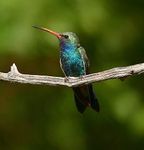Islands in the Sky: Birding the Chiricahua Mountains - Norcal Birding
←
→
Page content transcription
If your browser does not render page correctly, please read the page content below
Islands in the Sky: Birding the Chiricahua Mountains
of Southeastern Arizona
May 15-19, 2019
NorCal Birding
Southeastern Arizona offers some of the best birding in North America and
is one of the most illustrious birding areas in the country. This tour is
designed to introduce the novice and advanced birders to the unique variety of
bird species in the southeast corner of Arizona. This part of the U.S. is special
because it hosts a mixture of birds that only occur in this specific area including,
migratory species passing through, neotropicals that migrate from Mexico and
breed in the area and endemic birds of the desert and mountains. Many
neotropicals are only found in the United States only in the Sky Islands of
Southern Arizona. Bird species diversity is phenomenal in and around Portal
where over 400 species occur. If you have not been here before be ready to add
several species to your life list and observe some of the most stunning birds in
the country. This trip will be led by Ryan Phillips, a neotropical bird specialist and
Dave Zittin who has spent extensive time birding in the Portal area. Four nights
will be spent at the renowned Southwestern Research Station in the Chiricahua
Mountains, which is owned and operated by the American Museum of Natural
History. The accommodation is in the heart of this birding mecca and affords
exceptional birding out your doorstep, as well as dramatic landscape views.
General Itinerary:
Day 1: Wednesday: Arrive at Tucson International Airport (TUS), transfer by van to Portal,
afternoon or early evening feeder observations.
Day 2: South Fork Hike in morning, Portal feeder observations.
Day 3: High country, Onion Saddle, Barfoot Park, Rustler Peak, Paradise feeder stations
Day 4: Desert scrub, road stops, Willow Tank pond, Portal feeder observations.
Day 5: Return to Tucson, birding on the way back to the airportDetailed Itinerary:
Day 1: (May 15th, Wednesday): Arrive at Tucson, Drive to Portal
We check in at the Southwest Research Station before the office
closes at 5PM. Dinner on each day will be served at 6PM. We depart
for a short drive to the New Jasper feeding station to view birds in a
quiet setting before or after dinner
depending on our arrival time.
Each feeding station we visit
presents a great opportunity for
photography as we will be seated
during observations. We will likely
see Black-throated Sparrow,
Green-tailed Towhee, Canyon
Towhee, Northern Cardinal,
Pyrrhuloxia, Gambel's Quail, Northern Cardinal
Ladder-backed Woodpecker, Gila Photo David Zittin
Woodpecker, Arizona Woodpecker, White-winged Dove, Curve-billed
Thrasher, Scott's Oriole, Baltimore Oriole, Cactus Wren, Black-
chinned Sparrow, Bridled Titmouse, Verdin, Calliope Hummingbird,
Broad-tailed hummingbird and more.
Day 2: (May 16h, Thursday) South Fork Trail Hike
We pack sack lunches, have breakfast at the
station then do a short drive from the
Southwest Research Station to the South
Fork Trailhead where we hike about 1- 1.5
miles up stream on the South Fork of Cave
Creek. We will walk on loose river rock, high-
top hiking boots are recommended. We will
keep a keen ear and eye out for Elegant
Trogons that often roost in tall Arizona
Sycamore trees. Sulphur-bellied Flycatchers
Elegant Trogon may be heard calling. Our targets include
Photo David ZittinPainted Redstart,, Gila Woodpecker, Yellow-eyed Junco, Northern
Beardless-Tyrannulet, Canyon Wren, Mexican Jay, Plumbeous Vireo,
Bell's Vireo, Bridled Titmouse, Black-chinned Hummingbird,
Cordilleran Flycatcher, Dusky-capped Flycatcher, Brown-Crested
Flycatcher, Woodhouse's Scrub-Jay, Broad-billed Hummingbird,
Broad-tailed Hummingbird, Montezuma's Quail, Lucy's Warbler, ,
Whiskered Screech-Owl, Black-throated Gray Warbler, Virginia's
Warbler and more. Upon return, we will have lunch and drive to the
Cave Creek Ranch feeding station where
we should encounter the Mexican Jay,
Juniper Titmouse, Gambel's Quail,
Rivoli's Hummingbird, Blue-throated and
Broad-billed Hummingbirds, Scott's
Oriole, Western Tanager, Hepatic
Tanager, Black-headed Grosbeak, Inca
Dove and the Red-naped Sapsucker.
After dinner there will be optional night
birding around the station for Mexican
Whiskered Screech-Owl
Whip-poor-will, Flammulated Owl, Elf Photo David Zittin
Owl, and Whiskered Screech-Owl.
Day 3: (May 17th, Friday) High country (Forest Road 42), Onion
Saddle, Barfoot Park, Rustler Peak
We will have an early start after making bag lunches and having a
cold breakfast. After a 45 minute drive with birding along the route we
will be in the Onion Saddle-Barfoot Park-Rustler Park area. Here our
target birds will be the Zone-tailed Hawk, Northern Goshawk, Buff-
breasted Flycatcher, Cordilleran Flycatcher,
Dusky-capped Flycatcher, Greater Pewee,
Red-Faced Warbler, Olive Warbler, Grace’s
Warbler, Mexican Chickadee, and the rare
Short-tailed Hawk. Hiking will be involved in
this area. After we finish in this area, we will
drive to the George Walker House feeders
via Forest Road 42 and Paradise Road with
stops on the way as we sight birds. This
Broad-billed Hummingbird
Photo David Zittindrive should allow us additional opportunities to see the Mexican
Chickadee, Arizona Woodpecker and other alpine species we may
have missed earlier in the day. Our feeder stop, George Walker
House, is an excellent place to see a variety of hummingbird species
and another chance to see the Arizona Woodpecker and the Bronzed
Cowbird. Target species will be Rivoli's Hummingbird, Blue-throated
Hummingbird, Black-chinned Hummingbird, Broad-tailed
Hummingbird, Broad-billed Hummingbird, Arizona Woodpecker,
Cassin's Finch, Summer Tanager and Indigo Bunting. The drive
between Paradise and Portal affords an opportunity for rarities such
as Varied Bunting.
Day 4: (May 18th, Saturday) Desert Scrub and Desert Pond
After breakfast and making
up our bag lunches we will
drive down from the
mountains and head into a
desert environment. Our
goal is to reach Willow
Tank located southwest of
Portal which is very close
to the Arizona-New Mexico
border. We will take our
time stopping on the way
as we see birds. On the trip
Curve-billed Thrasher
Photo David Zittin
to the pond we hope to
encounter Abert's Towhee,
Vesper Sparrow, Black-throated Sparrow, Horned Lark, Brewer's
Sparrow, Yellow-headed Blackbird, Scaled Quail, Greater Roadrunner,
Swainson's Hawk, Cassin's and Western Kingbirds, Chihuahuan
Raven, Cactus Wren, Bendire's Thrasher, Eastern Meadowlark, Lucy's
Warbler and Blue Grosbeak. We will also search for the rarely
observed Lark Bunting. On our return from this area we will stop at
Bob Rodrigues' feeding station where we should see many desert
species and hummingbirds including the Scaled Quail, Montezuma'sQuail, Greater Roadrunner, Rivoli's Hummingbird, Blue-throated Hummingbird, Black-chinned Hummingbird, Broad-tailed Hummingbird, Cassin's and Western Kingbirds, Woodhouse's Scrub- Jay, Scott's Oriole, Northern Cardinal and Pyrrhuloxia. There will be optional night birding along the Cave Creek Canyon Road for Mexican Whip-poor-will, Flammulated Owl, Elf Owl and Whiskered Screech- Owl. Day 5: (May 19th, Sunday) Return to Tucson International Airport The plan is to bird, if at all possible on the way to the airport, time permitting. Where we go is tentative by design and will be based on last-minute bird reports and favorable location. Possible stops include Wilcox Lake, Patagonia Lake State Park and the Sweetwater Wetlands. Note: There will be optional pre-breakfast birding on Days 2, 4, and 5. Accommodation: Southwestern Research Station Website: https://www.amnh.org/our-research/southwestern-research-station/
You can also read
























































